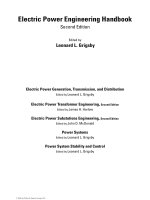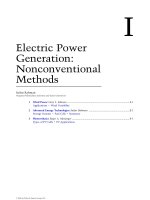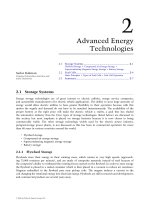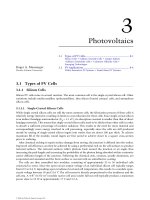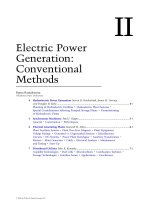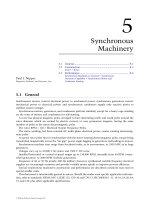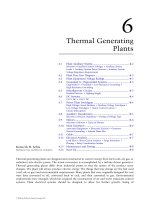power system stability and control chuong (5)
Bạn đang xem bản rút gọn của tài liệu. Xem và tải ngay bản đầy đủ của tài liệu tại đây (98.47 KB, 8 trang )
3
Photovoltaics
Roger A. Messenger
Florida Atlantic University
3.1 Types of PV Cells 3-1
Silicon Cells
.
Gallium Arsenide Cells
.
Copper Indium
(Gallium) Diselenide Cells
.
Cadmium Telluride Cells
.
Emerging Technologies
3.2 PV Applications 3-4
Utility-Interactive PV Systems
.
Stand-Alone PV Systems
3.1 Types of PV Cells
3.1.1 Silicon Cells
Silicon PV cells come in several varieties. The most common cell is the single-crystal silicon cell. Other
variations include multicrystalline (polycrystalline), thin silicon (buried contact) cells, and amorphous
silicon cells.
3.1.1.1 Single-Crystal Silicon Cells
While single crystal silicon cells are still the most common cells, the fabrication process of these cells is
relatively energy intensive, resulting in limits to cost reduction for these cells. Since single-crystal silicon
is an indirect bandgap semiconductor (E
g
¼ 1.1 eV), its absorption constant is smaller than that of direct
bandgap materials. This means that single-crystal silicon cells need to be thicker than other cells in order
to absorb a sufficient percentage of incident radiation. This results in the need for more material and
correspondingly more energy involved in cell processing, especially since the cells are still produced
mostly by sawing of single-crystal silicon ingots into wafers that are about 200 mm thick. To achieve
maximum fill of the module, round ingots are first sawed to achieve closer to a square cross-section
prior to wafering.
After chemical etching to repair surface damage from sawing, the junction is diffused into the wafers.
Improved cell efficiency can then be achieved by using a preferential etch on the cell surfaces to produce
textured surfaces. The textured surfaces reflect photons back toward the junction at an angle, thus
increasing the path length and increasing the probability of the photon being absorbed within a minority
carrier diffusion length of the junction. Following the chemical etch, contacts, usually aluminum, are
evaporated and annealed and the front surface is covered with an antireflective coating.
The cells are then assembled into modules, consisting of approximately 33 to 36 individual cells
connected in series. Since the open-circuit output voltage of an individual silicon cell ty pically ranges
from 0.5 to 0.6 V, depending upon irradiance level and cell temperature, this results in a module open-
circuit voltage between 18 and 21.6 V. The cell current is directly proportional to the irradiance and the
cell area. A 4-ft
2
(0.372-m
2
) module (active cell area) under full sun will typically produce a maximum
power close to 55 W at approximately 17 V and 3.2 A.
ß 2006 by Taylor & Francis Group, LLC.
3.1.1.2 Multicrystalline Silicon Cells
By pouring molten silicon into a crucible and controlling the cooling rate, it is possible to grow
multicrystalline silicon with a rectangular cross-section. This eliminates the ‘‘squaring-up’’ process
and the associated loss of material. The ingot must still be sawed into wafers, but the resulting wafers
completely fill the module. The remaining processing follows the steps of single-crystal silicon, and cell
efficiencies in excess of 15% have been achieved for relatively large area cells. Multicrystalline material
still maintains the basic properties of single-crystal silicon, including the indirect bandgap. Hence,
relatively thick cells with textured surfaces have the highest conversion efficiencies. Multicrystalline
silicon modules are commercially available and are recognized by their ‘‘speckled’’ surface appearance.
3.1.1.3 Thin Silicon (Buried Contact) Cells
The current flow direction in most PV cells is between the front surface and the back surface. In the thin
silicon cell, a dielectric layer is deposited on an insulating substrate, followed by alternating layers of
n-type and p-type silicon, forming multiple pn junctions. Channels are then cut with lasers and contacts
are buried in the channels, so the current flow is parallel to the cell surfaces in multiple parallel
conduction paths. These cells minimize resistance from junction to contact with the multiple
parallel conduction paths and minimize blocking of incident radiation by the front contact. Although
the material is not single crystal, grain boundaries cause minimal degradation of cell efficiency. The
collection efficiency is very high, since essentially all photon-generated carriers are generated within
a diffusion length of a pn junction. This technology is relatively new, but has already been licensed to a
number of firms worldwide (Green and Wenham, 1994).
3.1.1.4 Amorphous Silicon Cells
Amorphous silicon has no predictable crystal structure. As a result, the uniform covalent bond structure
of single-crystal silicon is replaced with a random bonding pattern with many open covalent bonds.
These bonds significantly degrade the performance of amorphous silicon by reducing carrier mobilities
and the corresponding diffusion lengths. However, if hydrogen is introduced into the material, its
electron will pair up with the dangling bonds of the silicon, thus passivating the material. The result is a direct
bandgap material with a relatively high absorption constant. A film wi th a thickness of a few micrometers
will absorb nearly all incident photons with energies higher than the 1.75 eV bandgap energy.
Maximum collection efficiency for a-Si:H is achieved by fabricating the cell with a pin junction. Early
work on the cells revealed, however, that if the intrinsic region is too thick, cell performance will degrade
over time. This problem has now been overcome by the manufacture of multi-layer cells with thinner
pin junctions. In fact, it is possible to fur ther increase cell efficiency by stacking cells of a-SiC:H on top,
a-Si:H in the center, and a-SiGe:H on the bottom. Each successive layer from the top has a smaller
bandgap, so the high-energy photons can be captured soon after entering the material, followed by
middle-energy photons and then lower energy photons.
While the theoretical maximum efficiency of a-Si:H is 27% (Zweibel, 1990), small-area lab cells
have been fabricated with efficiencies of 14% and large-scale devices have efficiencies in the 10% range
(Yang et al., 1997).
Amorphous silicon cells have been adapted to the building integrated PV (BIPV) market by fabri-
cating the cells on stainless steel (Guha et al., 1997) and polymide substrates (Huang et al., 1997). The
‘‘solar shingle’’ is now commercially available, and amorphous silicon cells are commonly used in solar
calculators and solar watches.
3.1.2 Gallium Arsenide Cells
Gallium arsenide (GaAs), with its 1.43 eV direct bandgap, is a nearly optimal PV cell material. The only
problem is that it is very costly to fabricate cells. GaAs cells have been fabricated with conversion
efficiencies above 30% and with their relative insensitivity to severe temperature cycling and radiation
exposure, they are the preferred material for extraterrestrial applications, where performance and weight
are the dominating factors.
ß 2006 by Taylor & Francis Group, LLC.
Gallium and arsenic react exothermically when combined, so formation of the host material is more
complicated than formation of pure, single-crystal silicon. Modern GaAs cells are generally fabricated by
growth of a GaAs film on a suitable substrate, such as Ge. A typical GaAs cell has a Ge substrate with a layer of
n-GaAs followed by a layer of p-GaAs and then a thin layer of p-GaAlAs between the p-GaAs and the top
contacts. The p-GaAlAs has a wider bandgap (1.8 eV) than the GaAs, so the higher energy photons are not
absorbed at the surface, but are transmitted through to the GaAs pn junction, where they are then absorbed.
Recent advances in III-V technology have produced tandem cells similar to the a-Si:H tandem cell.
One cell consists of two tandem GaAs cells, separated by thin tunnel junctions of GaInP, followed by a
third tandem GaInP cell, separated by AlInP tunnel junctions (Lammasniemi et al., 1997). The tunnel
junctions mitigate voltage drop of the otherwise forward-biased pn junction that would appear between
any two tandem pn junctions in opposition to the photon-induced cell voltage. Cells have also been
fabricated of InP (Hoffman et al., 1997).
3.1.3 Copper Indium (Gallium) Diselenide Cells
Another promising thin film material is copper indium (gallium) diselenide (CIGS). While the basic
copper indium diselenide cell has a bandgap of 1.0 eV, the addition of gallium increases the bandgap to
closer to 1.4 eV, resulting in more efficient collection of photons near the peak of the solar spectrum.
CIGS has a high absorption constant and essentially all incident photons are absorbed within a distance
of 2 mm, as in a-Si:H. Indium is the most difficult component to obtain, but the quantity needed for a
module is relatively minimal.
The CIGS cell is fabricated on a soda glass substrate by first applying a thin layer of molybdenum as
the back contact, since the CIGS will form an ohmic contact with Mo. The next layer is p-type CIGS,
followed by a layer of n-type CdS, rather than n-type CIGS, because the pn homojunction in CIGS is
neither stable nor efficient. While the cells discussed thus far have required metals to obtain ohmic front
contacts, it is possible to obtain an ohmic contact on CdS with a transparent conducting oxide (TCO)
such as ZnO. The top surface is first passivated with a thin layer (50 nm) of intrinsic ZnO to prevent
minority carrier surface recombination. Then a thicker layer (350 nm) of n
þ
ZnO is added, followed by
an MgF
2
antireflective coating.
Efficiencies of laboratory cells are now near 18% ( Tuttle et al., 1996), with a module efficiency of
11.1% reported in 1998 (Tarrant and Gay, 1998). Although at the time of this writing, CIGS modules
were not commercially available, the technology has been under field tests for nearly 10 years. It has been
projected that the cells may be manufactured on a large scale for $1=W or less. At this cost level, area-
related costs become significant, so that it becomes important to increase cell efficiency to maximize
power output for a given cell area.
3.1.4 Cadmium Telluride Cells
Of the II-VI semiconductor materials, CdTe has a theoretical maximum efficiency of near 25%. The
material has a favorable direct bandgap (1.44 eV) and a large absorption constant. As in the other thin
film materials, a 2-mm thickness is adequate for the absorption of most of the incident photons. Small
laboratory cells have been fabricated with efficiencies near 15% and module efficiencies close to 10%
have been achieved (Ullal et al., 1997). Some concern has been expressed about the Cd content of the
cells, particularly in the event of fire dispersing the Cd. It has been determined that anyone endangered
by Cd in a fire would be far more endangered by the fire itself, due to the small quantity of Cd in the
cells. Decommissioning of the module has also been analyzed and it has been concluded that the cost to
recycle module components is pennies per watt (Fthenakis and Moskowitz, 1997).
The CdTe cell is fabricated on a glass superstrate covered with a thin TCO (1 mm). The next layer is
n-type CdS with a thickness of approximately 100 nm, followed by a 2-mm thick CdTe layer and a
back contact of an appropriate metal for ohmic contact, such as Au, Cu=Au, Ni, Ni=Al, ZnTe:Cu or
(Cu, HgTe). The back contact is then covered with a layer of ethylene vinyl acetate (EVA) or other
suitable encapsulant and another layer of glass. The front glass is coated with an antireflective coating.
ß 2006 by Taylor & Francis Group, LLC.
Experimental CdTe arrays up to 25 kW have been under test for several years with no reports
of degradation. It has been estimated that the cost for large-scale production can be reduced to
below $1 =W. Once again, as in the CIGS case, module efficiency needs to be increased to reduce the
area-related costs.
3.1.5 Emerging Technologies
The PV field is moving so quickly that by the time information appears in print, it is generally outdated.
Reliability of cells, modules, and system components continues to improve. Efficiencies of cells and
modules continue to increase, and new materials and cell fabrication techniques continue to evolve.
One might think that Si cells will soon become historical artifacts. This may not be the case. Efforts are
underway to produce Si cells that have good charge carrier transport properties while improving photon
absorption and reducing the energy for cell production. Ceramic and graphite substrates have been used
with thinner layers of Si. Processing steps have been doubled up. Metal insulator semiconductor
inversion layer (MIS-IL) cells have been produced in which the diffused junction is replaced with a
Schottky junction. By use of clever geometry of the back electrode to reduce the rear surface recom-
bination velocity along with front surface passivation, an efficiency of 18.5% has been achieved for a
laboratory MIS-IL cell. Research continues on ribbon growth in an effort to eliminate wafering, and
combining crystalline and amorphous Si in a tandem cell to take advantage of the two different
bandgaps for increasing photon collection efficiency has been investigated.
At least eight different CIS-based materials have been proposed for cells. The materials have direct
bandgaps ranging from 1.05 to 2.56 eV. A number of III-V materials have also emerged that have
favorable photon absorption properties. In addition, quantum well cells have been proposed that
have theoretical efficiencies in excess of 40% under concentrating conditions.
The PV market seems to have taken a strong foothold, with the likelihood that annual PV module
shipments will exceed 200 MW before the end of the century and continue to increase by approximately
15% annually as new markets open as cost continues to decline and reliability continues to improve.
3.2 PV Applications
PV cells were first used to power satellites. Through the middle of the 1990s the most common terrestrial
PV applications were stand-alone systems located where connection to the utility grid was impractical.
By the end of the 1990s, PV electrical generation was cost-competitive with the marginal cost of central
station power when it replaced gas turbine peaking in areas with high afternoon irradiance levels.
Encouraged by consumer approval, a number of utilities have introduced utility-interactive PV systems
to supply a portion of their total customer demand. Some of these systems have been residential and
commercial rooftop systems and other systems have been larger ground-mounted systems. PV systems
are generally classified as utility interactive (grid connected) or stand-alone.
Orientation of the PV modules for optimal energy collection is an important design consideration,
whether for a utility interactive system or for a stand-alone system. Best overall energy collection on an
annual basis is generally obtained with a south-facing collector having a tilt at an angle with the
horizontal approximately 90% of the latitude of the site. For optimal winter performance, a tilt of
latitude þ158 is best and for optimal summer performance a tilt of latitude À158 is best. In some cases,
when it is desired to have the PV output track utility peaking requirements, a west-facing array may be
preferred, since its maximum output will occur during summer afternoon utility peaking hours.
Monthly peak sun tables for many geographical locations are available from the National Renewable
Energy Laboratory (Sandia National Laboratories, 1996; Florida Solar Energy Center).
3.2.1 Utility-Interactive PV Systems
Utility-interactive PV systems are classified by IEEE Standard 929 as small, medium, or large
(ANSI=IEEE, 1999). Small systems are less than 10 kW, medium systems range from 10 to 500 kW,
ß 2006 by Taylor & Francis Group, LLC.
and large systems are larger than 500 kW. Each size range requires different consideration for the utility
interconnect. In addition to being able to offset utility peak power, the distributed nature of PV systems
also results in the reduction of load on transmission and distribution lines. Normally, utility-interactive
systems do not incorporate any form of energy storage—they simply supply power to the grid when they
are operating. In some instances, however, where grid power may not be as reliable as the user may
desire, battery back-up is incorporated to ensure uninterrupted power.
Since the output of PV modules is DC, it is necessary to convert the module output to AC before
connecting it to the grid. This is done with an inverter, also known as a power conditioning unit (PCU).
Modern PCUs must meet the standards set by IEEE 929. If the PCU is connected on the customer side of
the revenue meter, the PV system must meet the requirements of the National Electrical Code
1
(NEC
1
)
(National Fire Protection Association, 1998). For a system to meet NEC requirements, it must consist of
UL listed components. In particular, the PCU must be tested under UL 1741 (Underwriters Laborator-
ies, 1997). But UL 1741 has been set up to test for compliance with IEEE 929, so any PCU that passes the
UL 1741 test is automatically qualified under the requirements of the NEC.
Utility-interactive PCUs are generally pulse code modulated (PCM) units with nearly all NEC-
required components, such as fusing of PV output circuits, DC and AC disconnects, and automatic
utility disconnect in the event of loss of utility voltage. They also often contain surge protectors on input
and output, ground fault protection circuitry, and maximum power tracking circuitry to ensure that the
PV array is loaded at its maximum power point. The PCUs act as current sources, synchronized by the
utility voltage. Since the PCUs are electronic, they can sample the line voltage at a high rate and readily
shut down under conditions of utility voltage or frequency as specified by IEEE 929.
The typical small utility-interactive system of a few kilowatts consists of an array of modules selected
by either a total cost criterion or, perhaps, by an available roof area criterion. The modules are connected
to produce an output voltage ranging from 48 V to 300 V, depending upon the DC input requirements
of the PCU. One or two PCUs are used to interface the PV output to the utility at 120 V or, perhaps,
120=240 V. The point of utility connection is typically the load side of a circuit breaker in the
distribution panel of the occupancy if the PV system is connected on the customer side of the revenue
meter. Connections on the utility side of the meter will normally be with double lugs on the line side of
the meter. Section 690 of the NEC provides the connection and installation requirements for systems
connected on the customer side of the revenue meter. Utility-side interconnects are regulated by the
local utility.
Since the cost of PCUs is essentially proportional to their power handling capability, to date there has
been no particular economy of scale for PV system size. As a result, systems are often modular. One form
of modularity is the AC module. The AC module incorporates a small PCU (%300 W) mounted on the
module itself so the output of the module is 120 V AC. This simplifies the hook-up of the PV system,
since NEC requirements for PV output circuits are avoided and only the requirements for PCU output
circuits need to be met.
Medium- and large-scale utility-interactive systems differ from small-scale systems only in the possi-
bility that the utility may require different interfacing conditions relating to power quality and=or
conditions for disconnect. Since medium-and large-scale systems require more area than is typically
available on the rooftop of a residential occupancy, they are more typically found either on commercial
industrial rooftops or, in the case of large systems, are typically ground-mounted. Rooftop mounts are
attractive since they require no additional space other than what is already available on the rooftop. The
disadvantage is when roof repair is needed, the PV system may need to be temporarily removed and then
reinstalled. Canopies for parking lots present attractive possibilities for large utility-interactive PV
systems.
3.2.2 Stand-Alone PV Systems
Stand-alone PV systems are used when it is impractical to connect to the utility grid. Common stand-
alone systems include PV-powered fans, water pumping systems, portable highway signs, and power
ß 2006 by Taylor & Francis Group, LLC.
systems for remote installations, such as cabins, communications repeater stations, and marker buoys.
The design criteria for stand-alone systems is generally more complex than the design criteria for utility-
interactive systems, where most of the critical system components are incorporated in the PCU. The PV
modules must supply all the energy required unless another form of backup power, such as a gasoline
generator, is also incorporated into the system. Stand-alone systems also often incorporate battery
storage to run the system under low sun or no sun conditions.
3.2.2.1 PV-Powered Fans
Perhaps the simplest of all PV systems is the connection of the output of a PV module directly to a DC
fan. When the module output is adequate, the fan operates. When the sun goes down, the fan stops.
Such an installation is reasonable for use in remote bathrooms or other locations where it is desirable to
have air circulation while the sun is shining, but not necessarily when the sun goes down. The advantage
of such a system is its simplicity. The disadvantage is that it does not run when the sun is down, and
under low sun conditions, the system operates very inefficiently due to a mismatch between the fan I-V
characteristic and the module I-V characteristic that results in operation far from the module maximum
power point.
If the fan is to run continuously, or beyond normal sunlight hours, then battery storage will be
needed. The PV array must then be sized to provide the daily ampere-hour (Ah) load of the fan, plus any
system losses. A battery system must be selected to store sufficient energy to last for several days of low
sun, depending upon whether the need for the fan is critical, and an electronic controller is normally
provided to prevent overcharge or overdischarge of the batteries.
3.2.2.2 PV-Powered Water Pumping System
If the water reservoir is adequate to provide a supply of water at the desired rate of pumping, then a
water pumping system may not require battery storage. Instead, the water pumped can be stored in a
storage tank for availability during low sun times. If this is the case, then the PV array needs to be sized
to meet the power requirements of the water pump plus any system losses. If the reservoir provides water
at a limited rate, the pumping rate may be limited by the reservoir replenishment rate, and battery
storage may be required to extend the pumping time.
While it is possible to connect the PV array output directly to the pump, it is generally better to
employ the use of an electronic maximum power tracker (MPT) to better match the pump to the PV
array output. The MPT is a DC–DC converter that either increases or decreases pump voltage as needed
to maximize pump power. This generally results in pumping approximately 20% more water in a day.
Alternatively, it allows for the use of a smaller pump with a smaller array to pump the same amount of
water, since the system is being used more efficiently.
3.2.2.3 PV-Powered Highway Information Sign
The PV-powered highway information sign is now a familiar sight to most motorists. The simpler signs
simply employ bidirectional arrows to direct traffic to change lanes. The more complex signs display a
message. The array size for a PV-powered highway information sign is limited by how it can be mounted
without becoming a target for vandalism. Generally this means the modules must be mounted on the
top of the sign itself to get them sufficiently above grade level to reduce temptation. This limits the array
dimensions to the width of the trailer (about 8 ft) and the length of the modules (about 4 ft). At full sun,
such a 32-ft
2
array, if 15% efficient, can produce approximately 450 W. Depending on location and time
of year, about 5 h of full sun is typically available on an average day. This means the production of
approximately 2250 Wh of energy on the typical day. Taking into account system losses in the batteries,
the control circuitry, and degraded module performance due to dirty surfaces, about 70 to 75% of this
energy can be delivered to the display, or about 1600 Wh=d. Hence, the average power available to the
display over a 24-h period is 67 W. While this may not seem to be very much power, it is adequate for
efficient display technology to deliver a respectable message.
ß 2006 by Taylor & Francis Group, LLC.
If the system is a 12 V DC system, a set of deep discharge batteries will need to have a capacity of 185 Ah
for each day of battery back-up (day of autonomy). For 3 d of autonomy, a total of 555 Ah of storage
will be needed, which equates to eight batteries rated at 70 Ah each.
3.2.2.4 Hybrid PV-Powered Single Family Dwelling
In areas where winter sunlight is significantly less than summer sunlig ht, and=or where winter electrical
loads are higher than summer electrical loads, if sufficient PV is deployed to meet winter needs, then the
system produces excess power for many months of the year. If this power is not used, then the additional
capacity of the system is wasted. Thus, for such cases, it often makes sense to size the PV system to
3/4 HP
MPT
AAAA
J
AAA
F F F F F
J
a. Simple PV-powered fan. b. Water pump with maximum power tracking.
55 W
modules
50 A
+ 1500 W
48vdc-
120vac
− Inverter
To main panel
neutral bus
GFI circuit
10 A
30 A
d. A h
y
brid residential installation.
8 A
A =
Start
100 A
φ2
φ1
2500 W
Gen
4 kW, 120/240 V
Controller/
Inverter
100 A
120/240 V
1
φ
3W
Main
Panel
# 8
#
10
#
4
c. A 1.5 kW residential rooftop utility interactive system connected on customer side of revenue meter.
To load side of 1P 20A
circuit breaker in main
a-c distribution panel
Fan
N
FIGURE 3.1 Examples of PV systems.
ß 2006 by Taylor & Francis Group, LLC.
completely meet the system needs during the month(s) with the most sunlight, and then provide backup
generation of another type, such as a gasoline generator, to provide the difference in energy during the
remaining months.
Such a system poses an interesting challenge for the system controller. It needs to be designed to make
maximum use of PV power before starting the generator. Since generators operate most efficiently at
about 90% of full load, the controller must provide for battery charging by the generator at the
appropriate rate to maximize generator efficiency. Typically the generator will be sized to
charge the batteries from 20 to 70% charge in about 5 h. When the batteries have reached 70% charge,
the generator shuts down to allow available sunlight to complete the charging cycle. If the sunlight is not
available, the batteries discharge to 20% and the cycle is repeated.
Figure 3.1 shows schematic diagrams of a few typical PV applications.
References
ANSI=IEEE P929, IEEE Recommended Practice for Utility Interface of Residential and Intermediate
Photovoltaic (PV) Systems, IEEE Standards Coordinating Committee 21, Photovoltaics, Draft 10,
February 1999.
Florida Solar Energy Center site with extensive links to other sites, including solar radiation tables.
http:== alpha.fsec.ucf.edu=$pv=inforesource=links=
Fthenakis, V.M. and Moskowitz, P.D., Emerging photovoltaic technologies: environmental and health
issues update, NREL=SNL Photovoltaics Program Review, AIP Press, New York, 1997.
Green, M.A. and Wenham, S.R., Novel parallel multijunction solar cell, Appl. Phys. Lett., 65, 2907, 1994.
Guha, S., Yang, J., et al., Proc. 26th IEEE PV Spec. Conf., 607–610, 1997.
Hoffman, R., et al., Proc. 26th IEEE PV Spec. Conf., 815–818, 1997.
Huang, J., Lee, Y., et al., Proc. 26th IEEE PV Spec. Conf., 699–702, 1997.
Lammasniemi, J., et al., Proc. 26th IEEE PV Spec. Conf., 823–826, 1997.
Messenger, R., and Ventre, J., Photovoltaic Systems Engineering, CRC Press, Boca Raton, FL, 1999.
NFPA 70 National Electrical Code, 1999 Edition, National Fire Protection Association, Quincy, MA, 1998.
Stand-Alone Photovoltaic Systems: A Handbook of Recommended Design Practices, Sandia National
Laboratories, Albuquerque, NM, 1996.
Tarrant, D.E. and Gay, R.R., CIS-Based Thin Film PV Technology, Phase 2 Technical Report, October
1996—October 1997, NREL, Golden, CO, May 1998.
Tuttle, J.R., et al., Proc. 14th NREL PV Program Review, AIP Conf. Proceedings 394, Lakewood, CO,
1996, 83–105.
UL Subject 1741, Standard for Power Conditioning Units for Use in Residential Photovoltaic Power
Systems, Underwriters Laboratories Inc., 1997.
Ullal, H.S., Zweibel, K., and von Roedern, B., Proc. 26th IEEE PV Spec. Conf., 301–305, 1997.
Yang, J., Banerjee, A., et al., Proc. 26th IEEE PV Spec Conf., 563–568, 1997.
Zweibel, K., Harnessing Solar Power, Plenum Press, New York, 1990.
ß 2006 by Taylor & Francis Group, LLC.



